Do you want to learn more about writing in the ancient world? Then read on!
I am excited to tell you that we recently received a small grant to develop some teaching materials based on our research on ancient writing systems and practices! Firstly, we want to make as many resources as we can available to the wider public, and we hope that lots of people will enjoy and learn from these – especially in these dark times when so many of us are isolated from each other, looking for something to take our minds off the news, and so many children are learning at home. This post is going to give you an idea of resources that are already available, and ones that are coming soon.
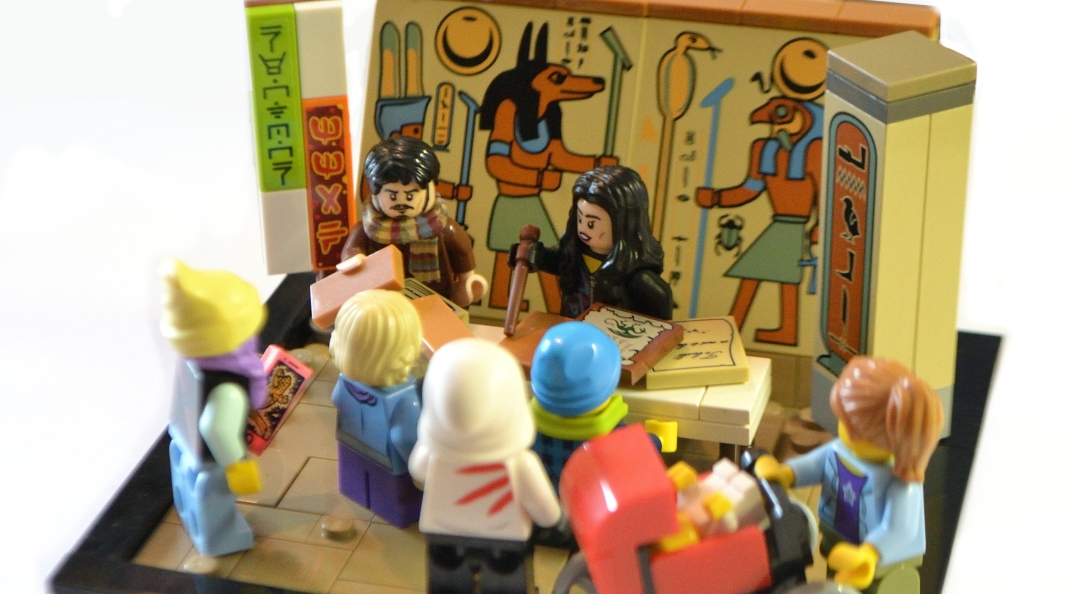
Eventually we aim to release packages of materials aimed at children aged 8-11, so do look out for more news on this if you teach in primary education or have children the right age!
Teaching with CREWS
The early history of writing is a fascinating story – or, rather, a fascinating set of stories – about how people in the ancient world developed ways of recording language and ideas, and how they interacted with each other, borrowing and sharing techniques of writing and adapting them to their own social and cultural settings. Even societies that use closely related writing systems tend to use them differently. They might encode their language in a different way, or use different types of implements and writing media, or have completely different ideas about what sort of people can/do write and what sorts of things get written down at all. Old fashioned approaches tend to focus on writing system structure and the languages represented, but at CREWS we have found it is absolutely vital to factor in the context of writing practices, building up a complex, multi-faceted picture to reflect a whole range of issues related to language, social practice and identity.
So writing makes a very good topic for teaching, for several reasons. For one thing, a lot of what we know about the ancient world comes to us through written sources, and it is important to try to understand how and why these were produced. At a broader level, writing gives us a window on many other features of society, from technology and education to gender and social status. And every piece of writing tells its own story about the people involved in its creation, bringing us closer to understanding the past.
In-depth articles on ancient writing
The first of our resources to introduce you to is the blog itself. Since the beginning of the CREWS project we have been writing periodic in-depth articles that introduce aspects of writing in the ancient world. One way to browse is to scroll through previous posts from the main page, but if you are looking for particular inspiration you can also look through our tags (see the tag ‘cloud’ at the bottom of this page on the right), or you can use the search box in the top right corner (hover your mouse over the magnifying glass symbol and click to type).
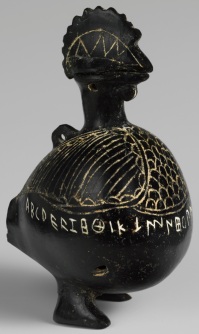
Some articles concentrate on a single writing system (e.g. Egyptian hieroglyphs, Ugaritic cuneiform, Mayan or Etruscan), a single society (e.g. writing in Mycenaean Greece, reconstructed in Lego) or even a single inscribed object (e.g. an ostracon inscribed in Punic from Wales, the Dolphin Stone from Archaic Crete or the Bisitun trilingual). Other posts look at broader themes, such as the ‘death’ of writing systems, the writing of indigenous languages, ancient myths about writing, the concept of calligraphy, inscribed objects that ‘speak’ to the reader and other issues related to writing and literacy.
And of course we have some playful blog posts too, such as a look at representations of cats in the Aegean scripts or a discussion of writing and magic, and maybe just one or two forays into writing-related topics in worlds of fiction (Indiana Jones, Walking Dead, Game of Thrones, Star Wars, more Star Wars, Dr Who, Tolkien, more Tolkien and even more Tolkien…).

I hope you will find plenty to interest you! The blog posts are written for the interested adult, but are suitable also for a slightly younger audience and have been used in high school and university teaching.
Visit the virtual CREWS display
In 2018 we were lucky enough to be involved in arranging a special display in collaboration with the Fitzwilliam Museum and British Museum: Writing in Cyprus and the Eastern Mediterranean. This brought together fourteen items from the two museums, chosen to illustrate some of the ways in which writing developed and was used in the societies around the eastern half of the Mediterranean and the Near East, from the Aegean to the Levant and from Egypt to Mesopotamia. Cyprus was a particular focus, and the star of the exhibition was the Idalion Bilingual, the inscription that provided the key for the decipherment of Cypriot syllabic writing.
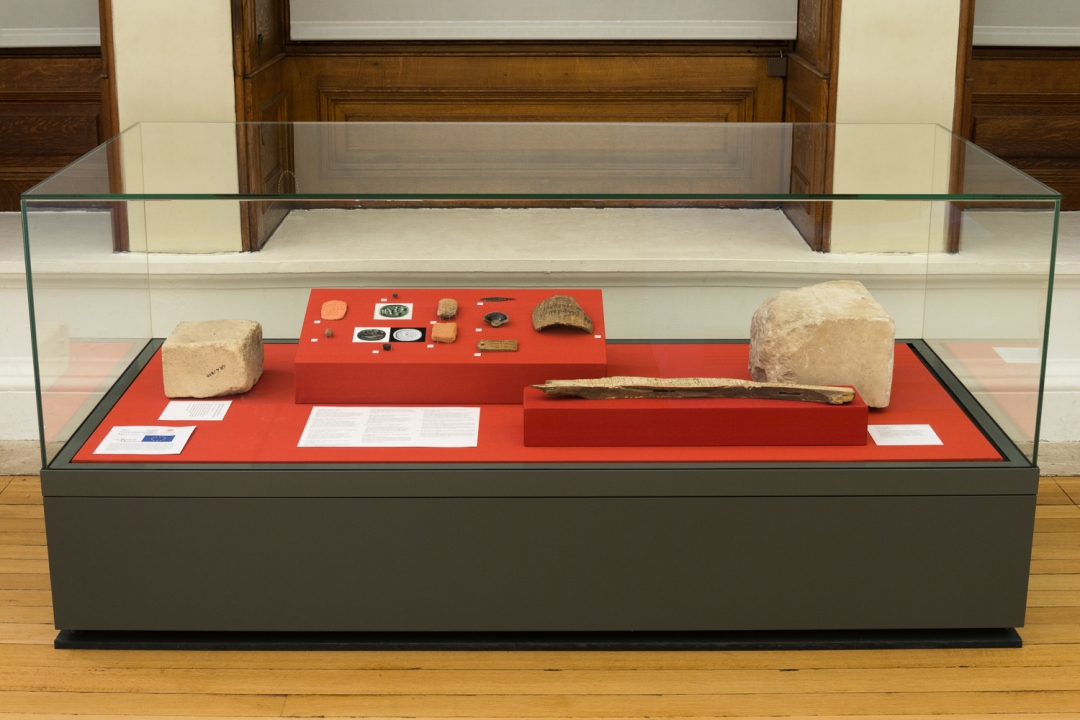
You can take our virtual tour of the display by clicking HERE.
The tour links to detailed discussions of each object featured in the display, so that you can tailor your tour to find out more about the items that interest you.
Learn an ancient writing system
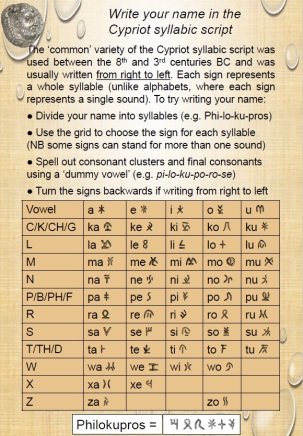
Writing systems are a bit like codes, with sets of symbols that ‘encode’ language such that one person can write down a message and another person can read or ‘decipher’ it without the first person having to tell them what it says. We have developed a series of ‘write your name’ sheets that teach you the basics of particular writing systems of the ancient world, so that you can write your name or a short message for yourself.
The sheets are in our Resources section HERE and can be downloaded for free.
You can just try experimenting with a simple pen and paper, but see the next section for ideas on ways in which you can experiment with ancient writing techniques too!
If you want a bit more guidance from the CREWS team, we’ve started making a series of short videos to accompany the worksheets. Have a look at the Write With CREWS page or visit our YouTube channel.
Tip: If you are going to try a particular writing system (on your own or with your family or a class), then have a search for CREWS blog posts on that system for a bit more context.
One of our favourite things to do is to experiment with materials and implements (or styli) to try to recreate the ways in which people in the ancient world wrote. This is an important research tool for us, because trying to recreate methods of writing helps us to understand these systems, and the social practices surrounding them, far better.
You will probably find that you have a lot of fun trying to replicate ancient ways of writing. Some writing systems are best tried in clay (e.g. Linear B using a round pointed stylus e.g. a bamboo skewer or cocktail stick, or any type of cuneiform using a stylus with a square or triangular end e.g. the back end of a chopstick). Others lend themselves particularly well to being written with ink or paint (e.g. Egyptian hieroglyphs). Some systems were used for lots of different types of inscription (e.g. Phoenician, the Greek alphabets or the Cypriot syllabic script), so your choice of method depends on what sort of writing you want to reproduce.
Most importantly, remember to have fun! You don’t need expensive materials to do this. Modelling clay works well for Linear B and cuneiform, but equally you could try normal plasticine. You don’t need papyrus – paper will do. And you can try writing on anything, even painting an inscription on a plant pot!
Tip: Children, please ask an adult for help in selecting your materials and implements, and avoid anything too sharp!
Make edible ancient inscriptions
You can even make inscription cakes and biscuits – which are just as viable as other media when you are trying out an ancient writing system! We have made quite a few over the years, and it is always good fun. If you click below you can watch a video showing you how to make biscuits that are particularly good for inscribing in the same way you would on clay.
You can also try using icing to make an inscription, e.g. on cake, or you can use a pointed object to scratch an inscription in chocolate. But if you don’t have the resources for special baking, don’t worry – just play around and see what you come up with! Here is a slideshow with some of our efforts in different edible forms.
Check out the CREWS YouTube channel
As you will have noticed if you click on the baking video above, we have a CREWS YouTube channel. At the moment, we mainly have recordings of conference presentations (which give in-depth discussions of writing practices in a number of different historical societies), and one or two other things, but soon we are hoping to add more content – so please keep an eye on our channel HERE.
We also have a very active Twitter feed, where we share news items, articles, pictures of inscriptions and other such things. You can see our most recent tweets in the sidebar to the right of our blog, and if you are on Twitter you can follow us to keep up to date with the latest in all things writing-related! Our handle is @crewsproject.
Get in touch with us!
We love to keep in touch with people all around the world who follow our project, or who are interested in ancient writing. If you have a go at any ancient writing related experiments, please let us know and even send pictures if you can! And if you have a question, please just ask – we will do our best to answer.

You can comment on blog post, send us a tweet or get in touch via our contact form or email. Visit the Contact Us page for more details HERE.
And finally… announcing our new project: Writing in the Ancient World
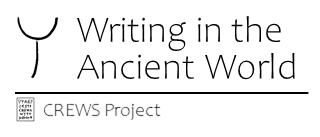
As I mentioned at the beginning of this post, we have just been awarded a small grant by the School of Arts and Humanities Impact Fund at Cambridge University to develop some specific teaching resources. That means the we are going to be releasing more content in the near future – so please keep checking back and follow us on social media for further announcements.
One strand of this new project involves developing teaching resources specifically aimed at children in the age 8-11 bracket. If you teach for this age group and are interested in introducing some content on the ancient world into the classroom, please get in touch and let us know – and we would be especially grateful if you could fill in our ongoing consultation HERE.
But now that we are all living in a very strange world for a while, where many of us are isolated at home and many children are unable to go to school, we want to try to get more general resources out to the public. Again please watch this space, and if you have any specific requests please contact us!
~ Pippa Steele (PI of the CREWS project)


Reblogged this on Ritaroberts's Blog.
LikeLike
Thanks Pippa, sounds good. Good luck !!
LikeLike
Hello, since I’ve been attempting to homeschool my 8 year old the various ‘learn an ancient writing system’ worksheets that you supplied have been terrific. My daughter is slightly behind the rest of her class in general literacy due to changing continents and educational systems and these tasks gave her a thrill. Partly because of the ‘secret code’ aspect, but also because it meant that she wasn’t looking at her own handwriting in a negative light compared to her schoolmates.
It’s still Easter school holidays in Australia so I haven’t been pushing too hard, but here are some general impressions which you can take as you want, but some might be useful for future educational resource development:
– the idea of secrecy and decipherment was exciting. She loved especially deciphering the name in the cartouche for the Egyptian hieroglyphics exercise and got annoyed in other exercises when the name was already revealed as an example, eg, Agamemnon. (Not sure how this might be done differently since Tutankhamen is well known but Telemachus and Agamemnon etc, are not so familiar to 8 year olds!)
– Sometimes the instructions were written in a way that could be read by an 8 year old, sometimes they were too technical and required an an adult to read them. Wherever possible it’s great if the instructions are designed to be read by the student because then the act of reading out loud becomes part of the exercise.
– she was entranced by the real or imagined iconicity in certain letters and this might be something that could be exploited. eg, the Linear B letter looked like a ‘man doing yoga’, which she then analyesd as ‘MAn doing yoga’
-Surprisingly she was not at all confused by the explanations that certain systems would not include the sounds in her name and that they might need to be approximated. This actually became part of the fun. Also fun was experimenting with right-to-left orientation, and she got out a mirror to project variable orientations of different letters.
-My own experience of this: I hate being a homeschool teacher so much, but when I’m teaching something I personally care about it then it’s not such a drag. So thank you!
We haven’t got through them all yet but will post more reflections later.
LikeLiked by 1 person
Thank you so much, this is very useful feedback! I am very glad that your daughter has found the exercises enjoyable.
LikeLike